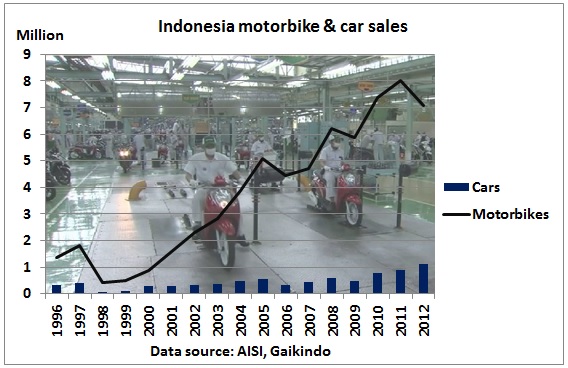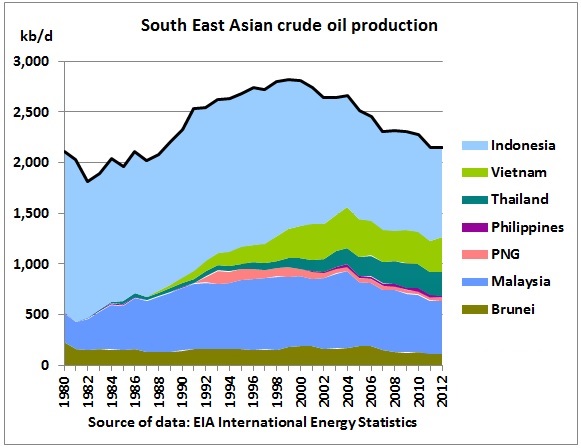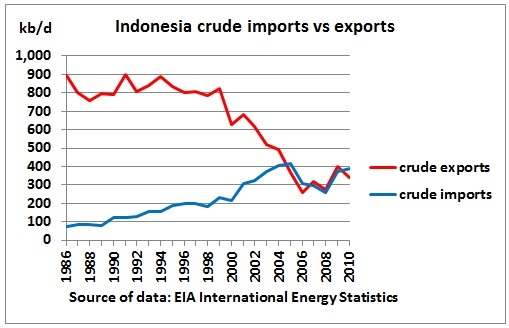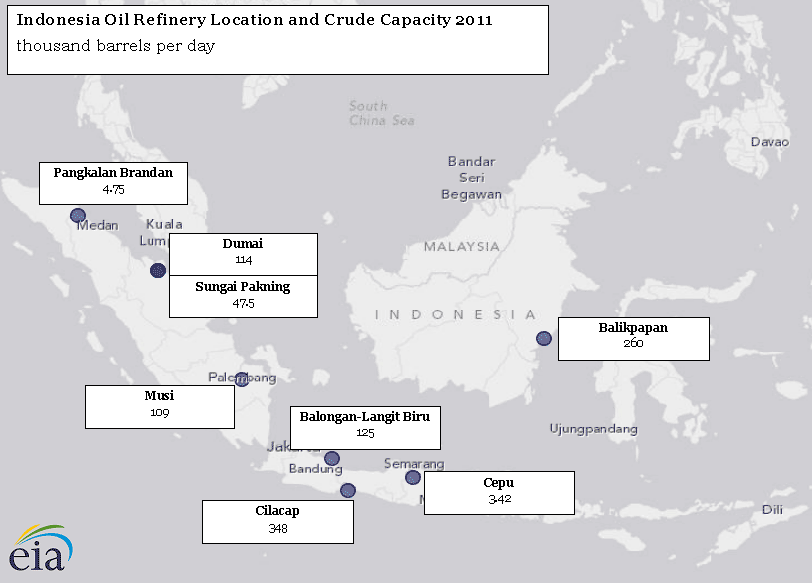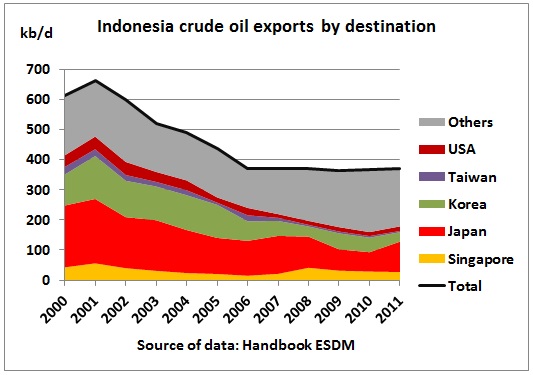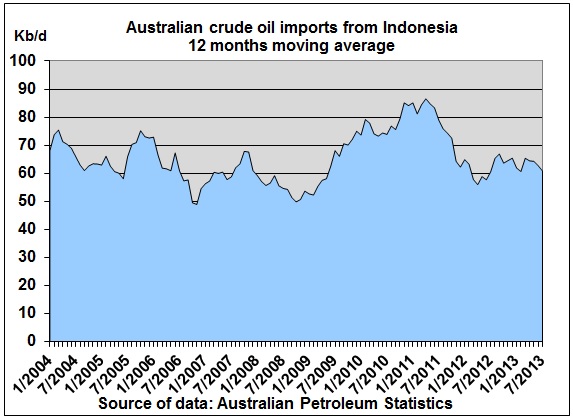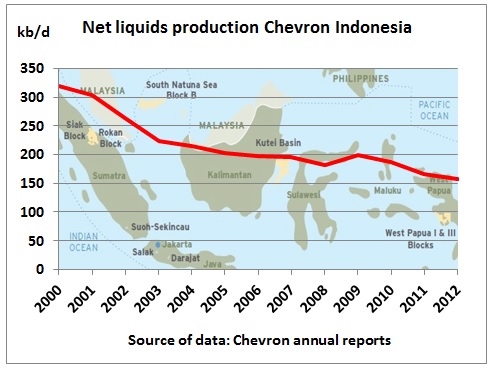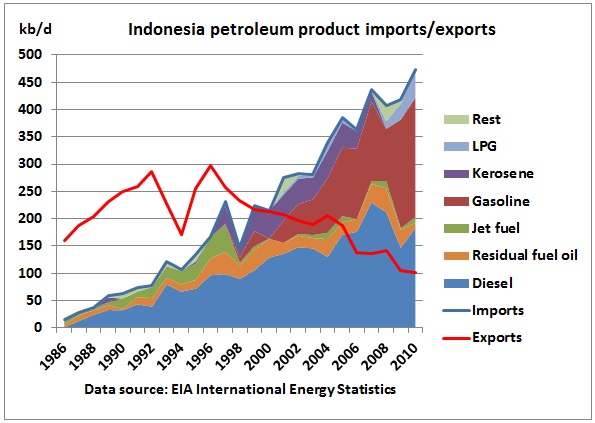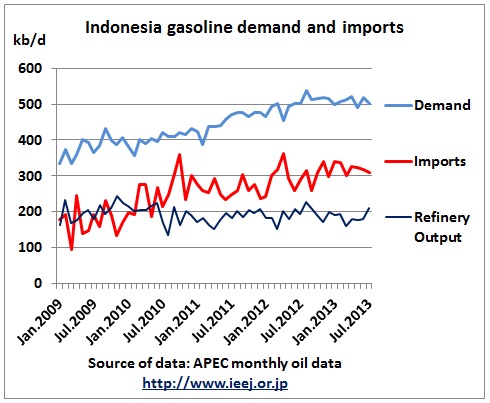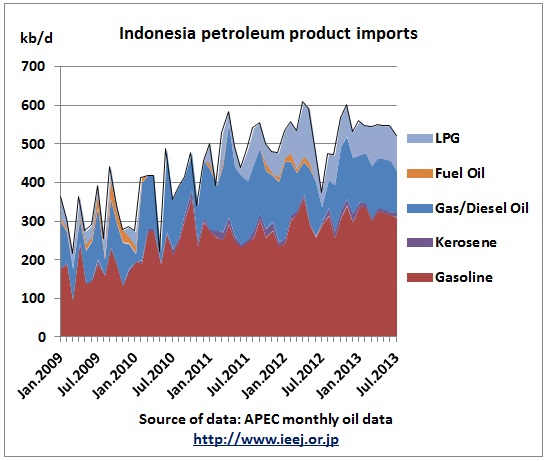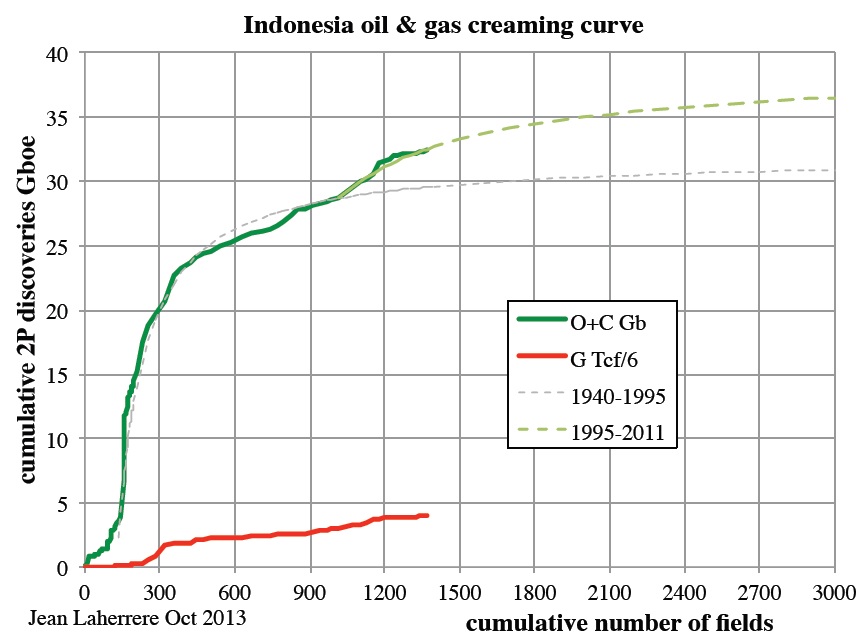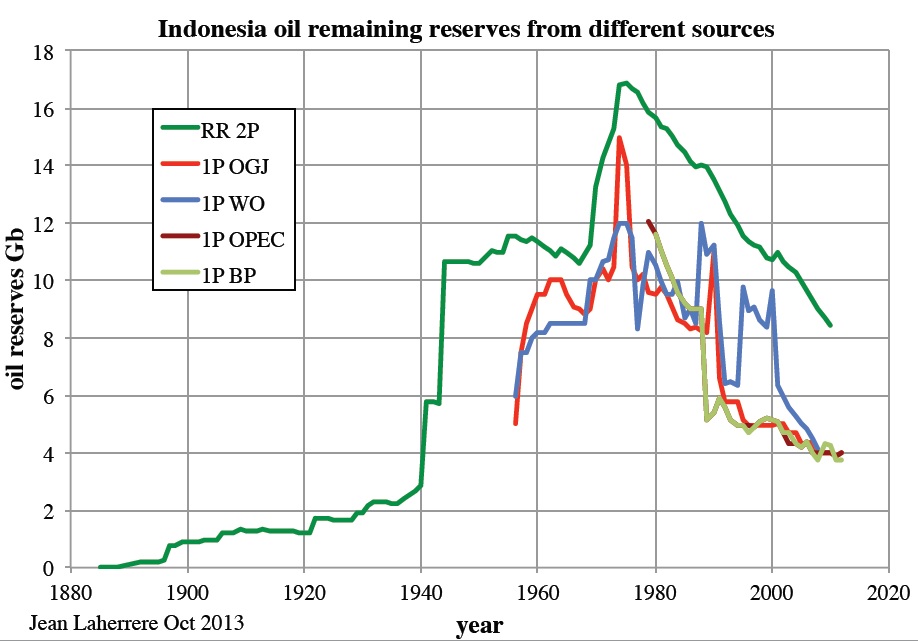At the recent Asia Pacific Economic Cooperation (APEC) summit in Bali the main theme was “Towards Resilience and Growth”. Two years earlier, at the Honolulu APEC summit in 2011 it was agreed to reduce energy intensities by 45% by 2035. This year, APEC’s energy working group focussed on renewable energies. The new Australian Prime Minister, Tony Abbott, for whom the Bali summit was the 1st appearance on an international stage, is certainly oblivious of, if not hostile to, these objectives as he wants to get rid of the Clean Energy Finance Corporation and plans to build the “roads for the 21st century”, namely motorways and road tunnels – which will rather increase the energy intensity of infrastructure – instead of energy efficient rail lines. That’s because he works under the assumption that peak oil has no value for policy making (“at the right oil price more reserves become accessible”). So let’s take Indonesia as an example to test Tony’s assertion . 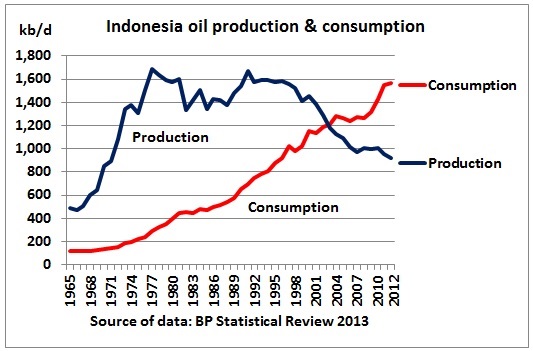 Indonesia is a net oil importer since 2003. In 2005, the government increased the price of subsidised fuel by 126% which caused a (temporary) drop in demand. In 2008, Indonesia left OPEC.
Indonesia is a net oil importer since 2003. In 2005, the government increased the price of subsidised fuel by 126% which caused a (temporary) drop in demand. In 2008, Indonesia left OPEC. 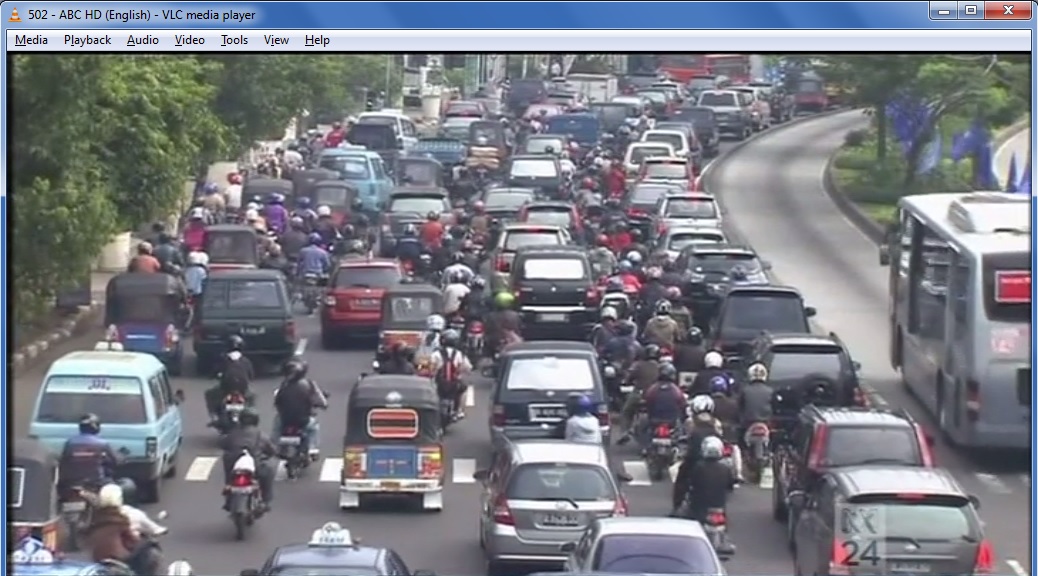
Post peak oil traffic in Jakarta: more motorbikes than cars – traffic model for the future or is it?
Rising numbers of motorcycles congest roads in Jakarta But Jakarta governor Fauzy Bowo says public transport is the solution http://www.youtube.com/watch?v=dj-pSsWpd8c
Data from: http://gaikindo.or.id/ and http://www.aisi.or.id/
Comparison to South East Asian neighbours
Indonesia shaped the South East Asian peak
Crude imports/exports
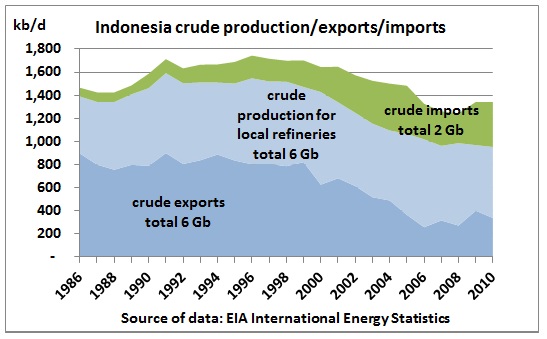 Over the period on this graph, half of Indonesia’s crude oil production (blue area) has been exported, something which will now be regretted as more and more crude (green area) has to be imported in order to keep the local refineries going.
Over the period on this graph, half of Indonesia’s crude oil production (blue area) has been exported, something which will now be regretted as more and more crude (green area) has to be imported in order to keep the local refineries going. 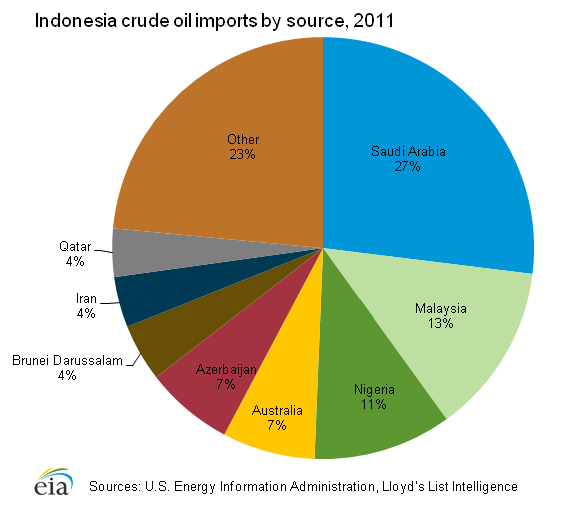
The Middle East dependency is (at least) 35%
Since 2005, crude oil exports more or less equal imports, suggesting that different types of oil needed by refineries are swapped. EIA data go only up to 2010 but more recent monthly data by APEC http://www.ieej.or.jp/egeda/database/database-top.html confirm these trends: 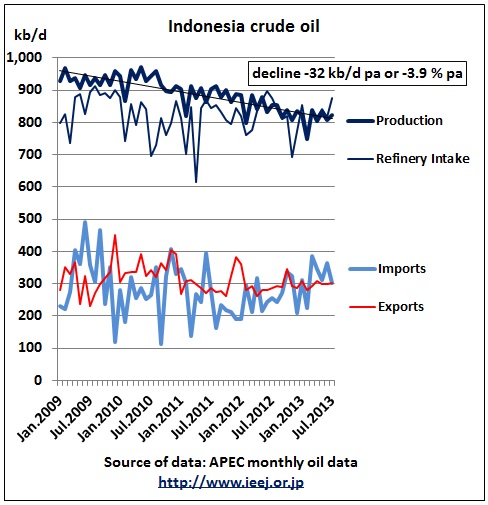
Using a trendline starting in 2009, the decline rate in crude production in 2012/13 was -3.9 % pa
Refineries
http://www.eia.gov/countries/cab.cfm?fips=ID
Total capacity of Indonesian refineries is around 1 mb/d. Given the above production and oil trade data, refinery utilisation is around 80%, on a declining trend, see slide 15 in: https://www.theice.com/publicdocs/Outlook_Global_Refining_Margins.pdf
Crude exports by destination
Data from: http://www.esdm.go.id/statistik/handbook.html
1/3 of “Others” is Australia:
Data from: http://www.bree.gov.au/publications/aps/
We see that Australia’s increase 2009-2011 coincides with a dip in Japan’s imports. Well done! But to no avail. Australia’s Shell refinery in Sydney has already closed and the Caltex refinery will follow in 2014. The following graph tells the story.
Chevron
Data from: http://www.chevron.com/news/publications/#b2
We may remember that Caltex told the media that Sydney’s growing demand for petrol will be supplied from Chevron.
27/7/2012 After Sydney’s refinery closure: Caltex to import fuel from Chevron’s shrinking sales http://crudeoilpeak.info/after-sydney-refinery-closure-caltex-to-import-fuel-from-chevrons-shrinking-sales
Product imports/exports
At present, EIA data go only up to 2010 …
…but monthly APEC data show gasoline imports continued to grow.
..while total product imports seem to have peaked (gap from missing data)
Oil reserves
 The nominal reserve to production ratio is appr. 3,700/(0.92*365)=11 years, basically unchanged for a decade, but at decreasing production levels (Abbott is therefore wrong in this instance). Cumulative production to 2003 was 20 Gb (see ASPO newsletter 46). From 2004 to 2012, around 3.3 Gb were produced.
The nominal reserve to production ratio is appr. 3,700/(0.92*365)=11 years, basically unchanged for a decade, but at decreasing production levels (Abbott is therefore wrong in this instance). Cumulative production to 2003 was 20 Gb (see ASPO newsletter 46). From 2004 to 2012, around 3.3 Gb were produced.  A simple Hubbert linearization yields around 32 Gb as ultimate so the depletion rate is 23.3/32= 73%
A simple Hubbert linearization yields around 32 Gb as ultimate so the depletion rate is 23.3/32= 73%
Fuel Subsidies
The German agency for international cooperation GIZ has analysed fuel subsidies around the world (2010), including South East Asia: 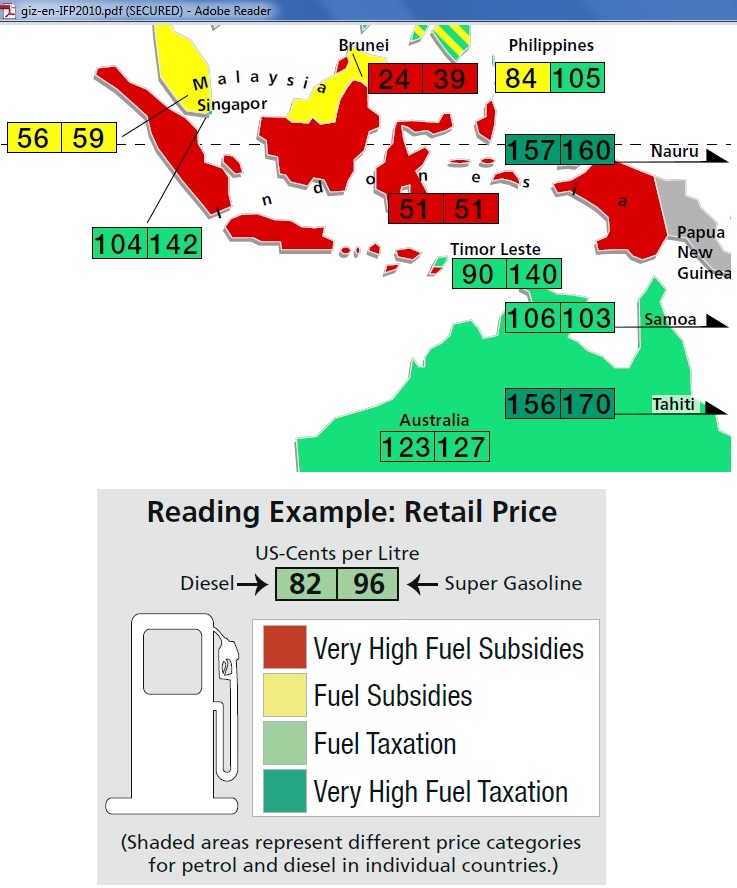 This is an excerpt from the Asia map. Indonesia has very high diesel and petrol subsidies.
This is an excerpt from the Asia map. Indonesia has very high diesel and petrol subsidies. 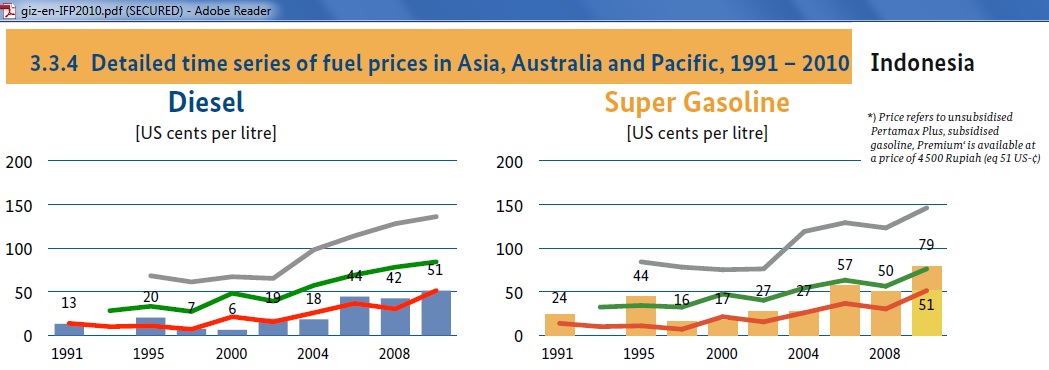 Grey benchmark line: retail price in Luxembourg, lowest in Europe Green benchmark line: retail price in the US (non subsidised minimum with 10 cents for road funding) Red benchmark line: crude oil price on world markets http://www.giz.de/Themen/en/29957.htm http://www.giz.de/Themen/en/dokumente/giz-en-IFP2010.pdf
Grey benchmark line: retail price in Luxembourg, lowest in Europe Green benchmark line: retail price in the US (non subsidised minimum with 10 cents for road funding) Red benchmark line: crude oil price on world markets http://www.giz.de/Themen/en/29957.htm http://www.giz.de/Themen/en/dokumente/giz-en-IFP2010.pdf
The IMF calculated in their staff report 12/277 that energy subsidies now basically consume the whole revenue from oil & gas. 
In 2011, energy subsidies were 3.4% of GDP
Data are from here: http://www.imf.org/external/pubs/ft/scr/2012/cr12277.pdf
Gasoline subsidies benefit higher income groups
.. At the global level, only 3% of petrol subsidies are received by the lowest-income quintile (the poorest 20% of the population) while the top quintile receives over 60%. As the IMF’s pie charts illustrate (below), the poor do better with subsidies on kerosene (used for lighting and cooking) http://www.lowyinterpreter.org/post/2013/05/13/The-deadly-politics-of-fuel-subsidies.aspx
At the global level, only 3% of petrol subsidies are received by the lowest-income quintile (the poorest 20% of the population) while the top quintile receives over 60%. As the IMF’s pie charts illustrate (below), the poor do better with subsidies on kerosene (used for lighting and cooking) http://www.lowyinterpreter.org/post/2013/05/13/The-deadly-politics-of-fuel-subsidies.aspx
Balance of payments
 In the same Sep 2012 IMF report projections on the balance of payments have been made for the next 5 years. Foreign direct investment (green line) is increasing while at the same time non-oil net exports (blue) decline due to non-oil imports increasing faster than non-oil exports. Rising net oil imports (red line) bring the balance of payments down to zero.
In the same Sep 2012 IMF report projections on the balance of payments have been made for the next 5 years. Foreign direct investment (green line) is increasing while at the same time non-oil net exports (blue) decline due to non-oil imports increasing faster than non-oil exports. Rising net oil imports (red line) bring the balance of payments down to zero.
In the meantime, the global economic environment has worsened.
Conclusion of 2013 Article IV consultation 30/8/2013 “An increase in net oil and gas trade imbalance has added to pressures. More recently, the prospect of a gradual exit from unconventional monetary policies in some advanced economies has prompted a marked shift in financing conditions for EMs, with the effects on Indonesia intensified by its external imbalances…. Under these conditions, the current account deficit is expected to widen to around 3½ percent of GDP in 2013. GDP growth is projected to slow to around 5¼ percent in 2013 …. Headline inflation is projected to rise to 9½ percent (year-on-year) by end 2013, factoring in June 2013 fuel price adjustments, before easing back to 6 percent in 2014…. To address macroeconomic pressures and reduce current vulnerabilities, BI has taken credible steps to tighten monetary policy, most recently through an increase on August 29 in its policy rate to 7 percent. Major fuel price adjustments in June 2013 have helped contain the fiscal deficit. Monetary policy should continue to focus on anchoring inflation expectations, reining in the current account deficit, and maintaining a healthy reserve buffer. Fiscal policy will need to support monetary policy in this effort, underpinned by further tax and subsidy reforms to ensure adequate space for social and capital spending, including new health protections in 2014. Early steps to further reinforce monetary and fiscal buffers, supported by continued flexibility in the exchange rate and bond yields, would help the economy absorb shocks.” http://www.imf.org/external/np/sec/pr/2013/pr13319.htm
Demonstrations against “fuel price adjustments” in June 2013:
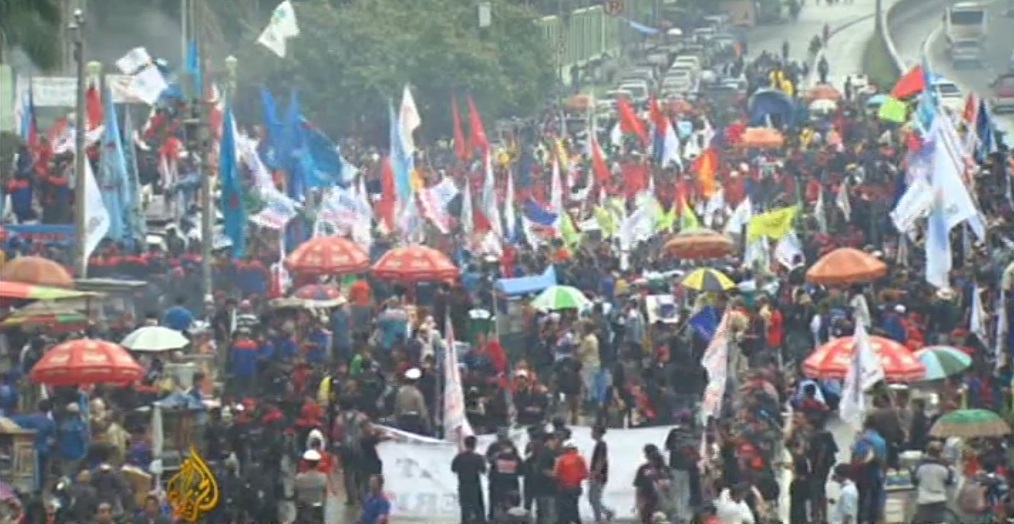 Indonesians rally against fuel price hike Parliament approves budget amendments paving way for first hike since 2008 amid widespread protests against decision.
Indonesians rally against fuel price hike Parliament approves budget amendments paving way for first hike since 2008 amid widespread protests against decision.
17/6/2013
http://www.aljazeera.com/news/asia-pacific/2013/06/20136178576532676.html
Conclusion
Expect more demonstrations against future subsidy reductions as crude oil and fuel imports need to increase to compensate for declining domestic oil production. Given the growing number of cars and motorbikes while at the same time not only Indonesian but also South East Asian oil production has peaked, there will be fierce competition with neighbouring countries for oil and fuels. That will put a relentless upward pressure on the Tapis oil price.
Related posts:
18/6/2013 South East Asian oil producers – the widening gap between oil production and consumption http://crudeoilpeak.info/south-east-asian-oil-producers-the-widening-gap-between-oil-production-and-consumption
20/11/2011 APEC energy intensity reductions: what it means for Australian oil consumption http://crudeoilpeak.info/apec-energy-intensity-reductions-what-it-means-for-australian-oil-consumption
Addendum on discoveries and remaining reserves
14/10/2013
Oil geologist Jean Laherrere who runs this website
http://aspofrance.viabloga.com/texts/documents
has provided his calculation for the 2P discoveries (proven and probable)
Ultimate 2P discoveries are around 36 Gb (slightly higher than the 32 Gb of proven reserves as estimated above). Note that the number of fields has to be doubled in order to get at an additional 10% of oil.
We see that Laherrere’s remaining 2P reserves are 8 Gb, double the 1P reserves as published in the BP statistical review. But due to the high depletion level (around 2/3 of oil has been produced) this will not change the fact that oil production will continue to decline.
Thanks, Jean, for your graphs.
